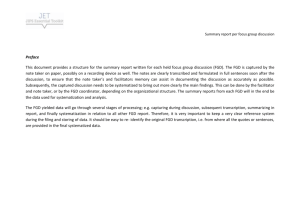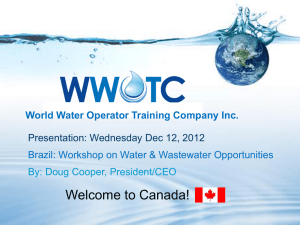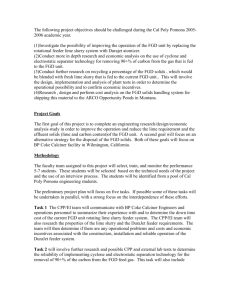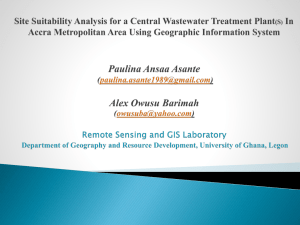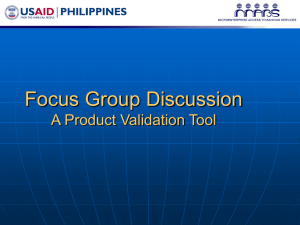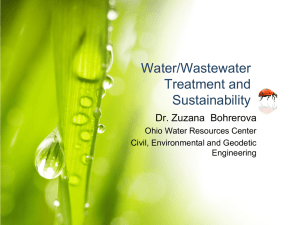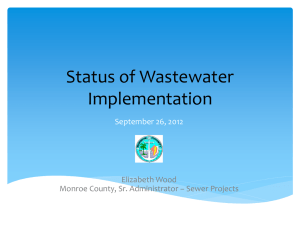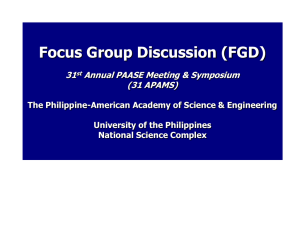Treatment and Discharge of FGD Liquid Wastes
advertisement
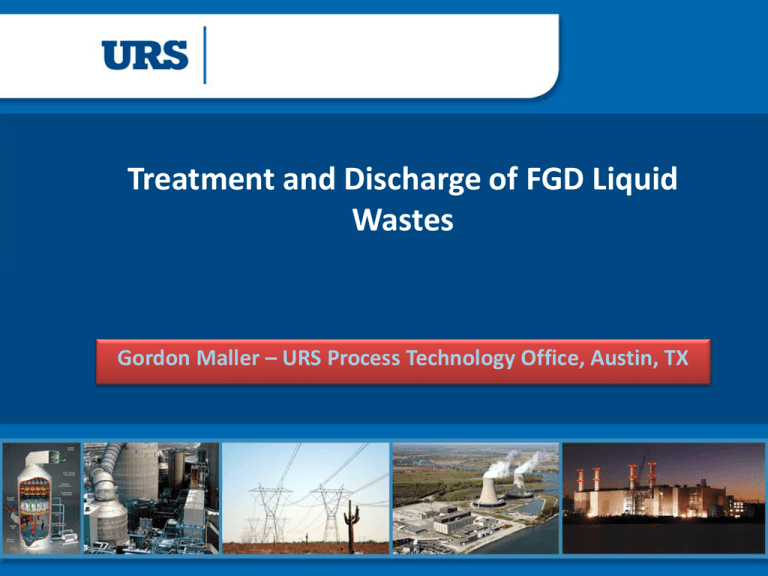
Treatment and Discharge of FGD Liquid Wastes Gordon Maller – URS Process Technology Office, Austin, TX Topics To Be Covered • • • • • Overview of regulations Properties of FGD purge water (wastewater) FGD design and operation Design considerations for WWT processes Discussion of WWT technology – Physical-chemical treatment – Biological treatment – Constructed wet lands • Discussion of ZLD technology • Summary and lessons learned Overview of Regulations • Current Regulations for plant liquid discharges to surface waters: – – – – Rules first issued in 1974 Clean Water Act Revised in 1977 and 1982 No changes in last 30 years Implemented through National Pollutant Discharge Elimination System (NPDES) program • EPA currently revising Effluent Limitation Guidelines (ELG) for power plants: – New regulations expected to be implemented between 2014 and 2019 through 5-year NPDES permit cycle – Based on BACT • Some state limits as low as: 1.3 to 12 ppt – Hg; 10 to 100 ppb - Se Scope of New ELG Regulations • • • • • FGD wastewater Fly ash transport water Bottom ash transport water Collected leachate and runoff from dry landfills containing CCR Flue gas Hg control wastes (e.g., ACI) FGD Wastewater • Wastewater a result of need to purge chlorides from scrubber – Corrosion of alloy materials – Ability of scrubber to obtain acceptable limestone utilization • Ways that Chlorides are purged from scrubber – Free moisture in FGD byproducts – Low solids purge stream • Characteristics of wastewater: – – – – – – Suspended solids Major species: Ca, Mg, Na, SO3, SO4 and Cl Trace species: As, B, Br, F, I, Hg, Se, Mn Heavy metals Nitrogen (nitrates and nitrites) ORP: Can affect oxidation state of Se and Hg FGD Wastewater (continued) • Composition depends on: – Properties of fuel, reagent and makeup water – FGD process design and operation • Wastewater from FGD can be saturated with gypsum. Can lead to scaling in WWT filtration and evaporation equipment FGD Design and Operation Can Affect Wastewater Properties • Forced oxidation versus natural or inhibited oxidation – ORP – Amount of free moisture in byproducts • High versus low chloride – Can affect sulfate levels and degree of gypsum supersaturation • Operation – Filtercake wash? – Filtercake free moisture What is ORP • Measure of redox potential of slurry. Indication if environment is oxidizing or reducing. Also indication of how strongly oxidized or reduced • ORP determined by: – Process: forced oxidized versus natural or inhibited oxidation – The presence and quantity of a number of reduced sulfur species, nitrogen species, and sulfur – nitrogen species – Trace transition metals • ORP can: – Determine form of selenium (selenite versus selenate) – Determine oxidation state of mercury – Can affect solubility of Mn which is thought to be a cause of under deposit corrosion of duplex SS and higher grade alloys Design Considerations for WWT Treatment • Concentration limits for pollutants in effluent • Design chloride level for FGD – Function of inlet flue gas conditions, makeup water properties and corrosion resistance of building materials – Determines the volume of purge water required – Economic trade-offs between cost of materials and volume of purge need to be evaluated during design phase • Purge stream should be as low in suspended solids as possible and should not be diluted • Properties of wastewater need to be considered in design of WWT system: pH, temperature, ORP, composition, degree of supersaturation Theoretical Scrubber Cl- Blowdown Rate Assumptions: 600 MW; Fuel HHV – 12,000 Btu / lb; Heat Rate – 10,500 Discussion of WWT Technology WWT Treatment Options • Physical-chemical treatment • Biological treatment • Constructed wet lands Overview of Physical-Chemical Treatment Source of flow diagram – CH2MHill Discussion of Treatment Steps 1. Desaturation a. b. c. d. Raise pH to about 8.5 – 9.0 with lime to precipitate metal hydroxides and gypsum Do not want to allow pH get too high and precipitate all of the Ca and Mg Retention time – about 30 minutes Sludge from first clarifier recycled to provide seed solids (nucleation sites) 2. 1st Clarifier a. b. c. d. e. Remove fine gypsum and other suspended solids Design similar to FGD sludge thickener Common to add flocculent to improve settling of solids Targeting 10 to 20 wt.% in underflow Typical overflow rate – 0.5 gpm/sft Discussion of Treatment Steps (continued) 3. Equalization Tank a. b. Used to provide consistent flow and composition for chemical treatment May be located upstream of desaturation tank or close to scrubber depending on number and location of influent streams 4. Chemical Treatment Tanks a. b. c. d. e. Metals removed by precipitation as metal-hydroxide or metal-sulfide (example: mercury-sulfide [cinnabar]) Metal-sulfides precipitate rapidly and are very fine and difficult to settle. To overcome this, sulfide is bonded with large organic molecule, organosulfide. This increase size of precipitate and makes it easier to settle Ferric chloride is dosed at high concentration and precipitates Metals co-precipitate with the iron and are removed (example – selenite) Retention times in chemical treatment tanks typically 10 – 15 minutes Solubility of Metal Hydroxides Discussion of Treatment Steps (continued) 5. 2nd Clarifier a. b. c. d. Used to settle precipitated metals to a solids concentration of 10 to 20 wt.% Typical overflow rate – 0.33 gpm/sft Lamella clarifiers are an option if space is limited Polymers (coagulant and flocculent) often added to facilitate settling 6. Effluent media filtration a. b. c. Used to remove un-settled suspended solids and metal precipitates Filters will need to be back-flushed Control of gypsum RS is important because filters are prone to scaling 7. Ion-exchange technology a. b. Sometimes used for challenging treatment applications (example – B removal) Very prone to scaling. Should not be regenerated with H2SO4 Discussion of Treatment Steps (continued) 8. Sludge dewatering a. b. c. d. Filter presses most common Work best at feed solids concentration of 10 to 20 wt.% Typical dewatered solids concentration 60 to 70 wt.% Sludge transported and disposed of in dry landfill Overview of Biological Treatment • Biological treatment (SBR) are located downstream of phys-chem treatment • Needed to remove BOD/COD, NO3, NO2, ionic Hg • Activated sludge process – need to maintain population of anaerobic bacteria to treat waste water • Anaerobic bacteria reduce ionic Hg to elemental form which is no longer soluble • Process typically more challenging for O&M – Problems with high or low temperature – Problems with high salinity – Works best with consistent influent flow and influent properties, does not work well as a batch operation Constructed Wetlands • Wastewater flows through microbial and bacteria rich material such as compost • Requires a large area for treatment • Novel vertical flow design is being evaluated as means to reduce size • At some point the bacteria rich material needs to be removed and disposed Discussion of ZLD Technology ZLD Treatment Options • • • • • Deep well injection Evaporative thermal process In duct evaporative process Wastewater spray dryer Non-thermal process Deep Well Injection • Deep well injection: – Waste must be treated before injection – Lower capital and O&M costs – Higher environmental risk – Not an option in some regions Evaporative Thermal ZLD • Evaporative thermal process: – Brine concentrator for initial concentration of wastewater • Reverse osmosis treatment • Thermal evaporative (e.g., Vertical tube falling film) – Crystallizer – Removal of suspended solids and Ca++ required prior to treatment – High capital and energy requirements – Dissolved salts present in FGD wastewater, like CaCl2, hydrolyze at high temperature and become acidic and corrosive – Fairly complex operating and maintenance requirements Block Diagram for Evaporative Thermal ZLD Wastewater Evaporation System • Direct injection of wastewater into ductwork • Salts collected with fly ash in particulate control device Wastewater Spray Dryer • • Addition of wastewater to small spray dryer installed in flue gas slipstream bypassing air heater Salts collected with fly ash in particulate control device Overview of Non-Thermal ZLD Process • Fixation and Blending for Disposal in Landfill: – Mixture of scrubber solids (e.g., gypsum), fly ash, lime (if required) and waste water to produce a cement-like product suitable for disposal in landfill – Non-thermal technology – No pretreatment of wastewater – Has potential to eliminate all discharges from plant (operate as ZLD plant) – Low capital and operating costs – Reduce quantity of ash available for resale – May be preferred option due to low cost and simple O&M Block Diagram for Non-Thermal ZLD Process Typical Composition of Stabilized Byproduct • 30-35% gypsum • 30-35% fly ash • 30-35% purge water • 2-4% lime Project Approach for Plant ZLD Operation Project Approach Non-thermal ZLD Mix FGD wastewater with scrubber solids (gypsum or sulfite), fly ash, and lime (if necessary) to produce a stable and fixated waste material. Place fixated waste material in dry landfill Return leachate and contact water to FGD Summary and Lessons Learned 1. Have good understanding of FGD process chemistry to improve ability to predict properties of purge water and capability of FGD system to process miscellaneous plant wastewater 2. Have a reasonable and accurate design basis for fuel, inlet flue gas properties, reagent and water 3. Operate and optimize FGD system to reduce and minimize quantity of wastewater and to produce a consistent purge stream in terms of volume and properties 4. Optimize plant water management to reduce volume of process streams 5. Consider full range of load conditions and fuel properties in design 6. Operate landfill to minimize volume of leachate and contact water Gordon Maller – URS Process Technology Office, Austin, TX gordon.maller@urs.com


